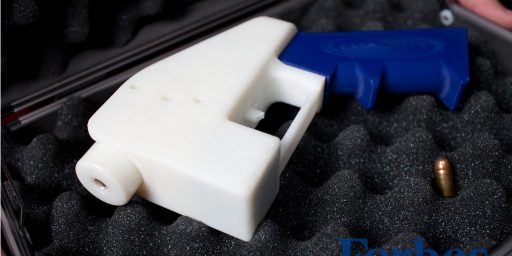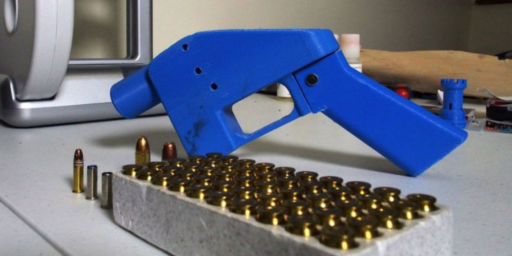3D-Printed Gun Successfully Fired
The gun which was created using a 3D printer has been tested and successfully fired:
The world’s first gun made almost entirely with a 3D printer has been successfully fired in the US. But it’s not going to herald an age of widespread weapon ownership, and it’s certainly not proof that 3D printing technology needs to be controlled for our safety.
The gun – called the “Liberator” and produced by Defense Distributed, a group that describes itself as aiming to “defend the civil liberty of popular access to arms” through “information and knowledge related to the 3D printing of arms” – is the second to have made the headlines in the past year. In July, an American gunsmith printed the lower receiver for an AR-15, a type of modular assault rifle popular among enthusiast. Although not capable of firing on its own, the part is the only component legally considered a firearm in the US, so the rest of the gun – the barrel, trigger, cartridge and so on – could be bought without a licence.
The Liberator is a more serious prospect. All of the necessary parts can be printed from a 3D printer except for the metal firing pin, which is made from a single nail. (In order to comply with US laws, the gun as produced also has a 175g chunk of steel inside it, so that it doesn’t evade metal detectors). It is a fullblown gun, and recognisably so.
But technologically, it’s still simple. That’s because the principle behind a gun isn’t too tricky: load a bullet into a reinforced tube, and whack the back of it hard. That’s an engineering problem street gangs in the 1950s managed to solve with wood, antenna housings and elastic bands, building “zip guns” to shoot at each other; and it’s also the basis for converted air rifles and cap guns. The difficult stuff – getting it to fire accurately, repeatedly and without jamming or blowing up in your face – is still a long way off for 3D printers. And even the best 3D-printed gun still relies on someone else to make the gunpowder.
Here’s the video:
Now that this technology is out of the bottle and in the public domain, controlling it is going to be next to impossible.







I love a product that a) can likely only be used once before it destroys itself, and b) when it malfunctions, which is highly likely, will seriously injure the user.
Gun nuts, please print these and use them. A lot. Thank you.
I’ve been reading a lot about, and listening to interviews with, Mr. Cody Wilson regarding his plastic gun.
He fully admits that his gun is substandard to traditionally made firearms, however he makes an argument that one day soon technology will exist to make firearms at home that are just as deadly as commercially made firearms. He claims he is making an ideological argument that with today’s technology, gun control measures may not be as effective as proposed.
His best argument lies not with a fully homemade pistol, but with large capacity magazines. If high capacity magazines were banned, what is to stop someone at home from manufacturing a 30 round clip made from plastic and a spring? And if one had nefarious purposes in mind, who cares if it lacks durability – all it needs to do is last for one use.
I don’t necessarily agree with Mr. Wilson’s ideology, but at least it is reasoned and consistent.
Cheers.
@mantis: Yeah, the entire concept of making a firearm out of substances that can be molded by a commercial 3D printer just gives me the jibblies. Do not want. Let the gun nuts blow a few of their own hands off…
The gun nutters will be over the moon with this knowledge. They can never have enough guns no matter in what shape or form they come. The gun mentality is really sad. Idiots like Sarah Palin, Wayne LaPierre, Glen Beck etc keep the flames burning of an imminent threat of their guns being taken away. All totally insane, but then so are they!!
@PogueMahone:
If the argument is rational, it can only be by projecting 3-d printers far, far, far, beyond anything available today.
Not even high end commercial printers can do plans-in-guns-out. They can produce metal parts (with voids!), which a skilled gunsmith could assemble. It is possible that such a gun could handle low pressure rounds. But a teenage spree shooter is not going to “print a gun and go.”
(Note that high capacity magazines require high tolerance springs, which cannot be printed on any machine today.)
@mantis:
It’s not a product, it’s proof of concept. It’s all better and better from here on out.
There were those who didn’t want a product made from stamped parts not hand fitted, but now millions fly across the landscape at high speed in the same product made with a lot of plastic. Don’t you worry about it, the youngsters will innovate while you sit about stewing in your own juices.
No they don’t. In any case, the printed high capacity magazine was demoed months ago. Fed like a champ.
You might argue such “high tolerance” for long reliable service life. No one is going to carry a printed gun for self defense for the time being. But then a hundred years ago, there were those who derided those fancy automatic pistols as never being reliable enough to replace to old six-shooter revolver.
@john personna:
Until recently, the very idea of functional 3D printers that were small enough to put on a table in your house was inconceivable.. This technology is just in its infancy
@JKB:
You understand that residents of most states can buy a much, much, better gun here, legally, over the internets?
Pietta Model 1851 Confederate Navy .44 Caliber Revolver
@JKB:
As I say, that good old six-shooter is lightly regulated, because it is not considered a criminal’s choice.
But as I say, I don’t think anyone can print a spring. Go ahead and show me if the “printed magazine” was a cheat, as I suspect, with ordered parts.
@Doug Mataconis:
As I’ve said, it disturbs my engineering mind that people think “3d” is the thing, overriding materials science.
@Doug Mataconis:
It is analogous to the “oh noes, self-driving cars” articles.
People without an understanding of technical hurdles will sometimes think that things are “almost” when they are decades away.
@john personna:
Several people I’ve seen comment about this with an engineering background have said that describing this technology as “3d printing” isn’t really the best way to describe it.
Sure it will. As I said in the other thread, take a $20 to your nearest color copier and see what happens when you try to copy it.
In other news, I can make a zip gun out of stuff I can buy at Home Depot!. And for less than $20.00!
I guess that means all gun laws are now unenforceable. Or not!
@Doug Mataconis: Don’t try to reason with JP. In JP’s world technological advancement is slowly greatly and things like printed guns will never happen.
In reality the technology behind 3d printing is advancing at an ever faster pace. They’ve already developed commercial methods of 3d printing metals that are damned close to the same strength as cast metal.
@Doug Mataconis:
You misunderstand.
Let’s back up. In the beginning there was the SciFi concept of a matter replicator. Wouldn’t that be neat? And so people started to project how it could be done without Star Trek magic. The idea they came up with (just conceptually now) was that products would be printed in 3d. You could print yourself an iPad, or anything.
That was a neat enough idea that people started working on it. Someday they may get to the replicator, and you may be able to do plans-in and iPad-out, or gun-out.
But everything 3d is not equal. Think about the 3d things in your life now. You may go buy a cap for the cat food can at the 99 cents store. You may still drop hundreds at the Apple store.
Right now, the best any 3d home printer can do is make that 99 cent cover for your cat food can.
People have been “innovative” in trying to make things work in cheap plastic, but that is not at all the same as making the home printer work in steel, let alone in dynamic mixes of materials, anytime soon.
@Matt:
It is just not true that every true believe in every future technology is right.
I mean, hydrogen fuel cell cars?
They had believers as big as you 30 years ago.
Basically, someone builds a plastic gun and says “the AR-15 is in the mail.”
Believe that at your own risk.
@john personna: Hydrogen fuel cells are used in a variety of applications. There’s at least 100 fuel cell powered buses around the world.
http://en.wikipedia.org/wiki/Fuel_cell
For god’s sake the German’s and Italian’s use the technology in their submarines..
Nasa has been using the technology for some time now (decades at least)…
I’m talking about technology while you’re still stuck on a specific application which is why you went with fuel cell powered cars..
@Matt:
So you cheat right back at me again?
I specifically said hydrogen fuel cell cars.
@john personna: I didn’t say anything about hydrogen fuel cell cars. You brought it up so I thought maybe you’d like to know how the technology did pan out and quite well. You’re smart enough to know why the entrenched interests were able to assist in defeating the widespread adoption of fuel cell powered cars. You’re desperate at this point..
You’re basically falling into the same general fallacy as you did with the model t crap.
Hydrogen Fuel-Cell Cars Not Viable, Says Volkswagen CEO
In a way they are analogous to your claim though. “Demonstration” cars have been done time and time again, with millions invested. Maybe even billions.
No one can deliver at a useful price point to the home user.
@Matt:
I brought it up, and you argued by changing the subject, as has been your pattern.
@john personna: It’s a cherry picked example of a technology that emerged in many successful applications. You know that if there wasn’t so many powerful industries against the concept of electric or fuel cell powered cars that we’d see more of them on the road..
You know this and you insist on being dishonest because you hope that either I’m too stupid or the readers are too stupid to see through your crap.
@Matt:
I used jet packs and flying cars in the other threads. To that I add hydrogen fuel cell cars. Every city of the Future was wrong. Video phones were “almost there in the 60s” (40 years early). Immersive virtual reality was “almost there in the 80’s” (30-40 years early, the clock is ticking.)
The point here is that nobody just gets to say “my future is true.”
You have to build it, and THEN you can say you were right.
@john personna: Interesting that Mercedes-Benz Honda and Toyota all disagree with that dude from VW. Even the head guy at GM said it’s only a matter of time (within 10 years according to him).
In the meantime one of if not the most powerful industry in the world will continue their fight against any non gasoline burning vehicles..
@john personna: I provided links to working jetpacks you could buy right now. I explained clearly why the 3d setup of a flying car is impractical from a driver perspective.
No one seriously thought widespread usage of video phones was almost there in the 60s.
Meanwhile there’s already metal 3d printers which are capable of creating objects almost as strong as cast steel via special processes. The technology is already there it just needs refined some more for home use.
@Matt:
No (he said patiently) the only economic way to make hydrogen today is from natural gas, and you can directly power vehicles with natural gas much more efficiently.
That is the reason buses run on natural gas, and a natural gas honda civic will only cost you $22 grand or whatever.
@Matt:
Are just dumb?
“where is my jet-pack?” means the original promise.
I want a jet pack I take to work every day.
This is exactly the bait and switch your arguments all live upon.
@john personna: @Matt:
Hey dude, where’s the 3d printer/matter replicator that can produce a three course dinner with the press of a button? What about the personal robot manservant that will lay out my clothes for me? And the fusion reactor? And the warp drive?
Technology is a wonderful thing. But there is no iron law that says that technology will inevitably progress in a straight line from what we have now.
Frankly, I think its a lot more likely that we will see 3d printing of plastic explosives such as C-4 in a near future. Won’t that be fun!!
I guess it makes sense, you think a conspiracy is keeping hydrogen cars off the road, and you think 3d guns are any day now.
@john personna: http://www.sciencemag.org/content/340/6128/60.abstract
@john personna: I linked you to a jetpack you could take to work…
@stonetools:
AFAIK no printer commercial or domestic can “print” chemical synthesis.
@john personna:
You make a very good point here. We really don’t now where this technology will lead, or even if it will lead anywhere fruitful in the near future. Still, it is pretty cool that we’ve gotten to this point.
@john personna: It’s not a conspiracy it’s simple economic facts. Corporations have always used whatever power they have to provide for a favorable business environment. When you’re the richest companies in the world you have a lot of resources to ensure that..
Here’s a simple “conspiracy” that you should understand. Look at how diamonds evolved from a nearly worthless rock to it’s current status as a “valuable” material. All thanks to a cartel and extensive marketing and PR manipulation.
@Matt:
That is not a price per pound that is another dodge and another dream.
@Matt:
Bullshit.
@Doug Mataconis: Well I know that our material technology allows for us to “3d print” metal parts that are almost as strong as cast steel. I also know that we made guns out of some pretty terrible quality metal through the centuries. During WW1 and then WW2 the steal being used was of serious inferior quality to what we can do today. That inferior steel has held up in guns such as the mosin nagant which has been around since 1891 and fires a high powered 7.62x54r cartridge that is lethal out past 1000 meters.
@Matt:
I’d like to note that after all Matt’s bashing of me, he admits here what I said in the other thread:
That is less than cast steel, and of course less than forged steel.
Commercial firearms use forged steel for their barrels and many of their parts, and so not even the high end commercial 3d printers can truly replicate them. To make a gun, you’d have to make a blocky design compensating for weaker materials.
Barrel Making: The Rise of Steel Barrels
Slate’s Future Tense takes they pessimistic position:
You Can Now 3-D Print Your Own Working Gun, But You Probably Shouldn’t
They end:
“Until then, there’s a decent chance that the first person who tries to kill someone with a 3-D printed gun will end up as an unintended casualty himself.”
3D printing is cool, and useful in a lot of ways. 3D printing something meant to contain and direct an explosion out of the plastic materials used for home 3D printing is idiotic (there are industrial machines that can do this with the materials and tolerance needed for a safe weapon, but would probably be more expensive than traditionally manufactured guns). Expect to see YouTube videos of morons maiming themselves in the near future.
This is for all those who seem so self assured when predicting future technology.
@Andy:
I’m sure you noticed that I never said never.
My argument is quite the opposite, that you can’t promise a delivery of a wished for technology.
See also survivorship bias (which is pretty much the theme of your list.)
@john personna:
And I’m sure you noticed I never mentioned you specifically, nor did I ever claim anyone was taking an absolutist position….
@Andy:
Sure, and it was good that you got me to work in survivorship bias directly. This bit is good:
Keep telling yourself that….
The only reason this technology would be used to make a gun is to A) make a point (not what guns do) or the B) avoid regulation for nefarious purposes.
A has already been accomplished. B will be soon. And when it does, do not expect a bunch of “Welp, we can’t control it” stuff. Uh huh…..that’s not how these things work.
@john personna:
Yep, I’m familiar with that. That’s not the only bias out there, however.
The only thing I’m reasonably confident about is that no one in this thread really knows what this technology will be capable of.
@Andy:
Which technology?
Remember, “3d” is a coordinate system 😉
Systems of additive 3d manufacturing, technologies, are listed here.
Automated milling machines, cnc, etc. have been in place longer, for reductive 3d production.
Oh, come on. You guys aren’t keeping up.
Successful test of a 3-d printed firearm
Staples is just starting to sell 3-d printers
Remember who was integral to the start of Staples (hint, it was mentioned in the last Presidential election)
Now, let’s get some righteous indignation going…
@JKB:
Please print a gun using machinery you can get at Staples and fire it. I’ll buy the gunpowder.
@john personna: We used cast steel for gun barrels for a VERY long time.
Since you have no apparent sense of history involving gun components you should at least read this link.
http://en.wikipedia.org/wiki/Gun_barrel
Notice that bamboo was used as a barrel..
Hell there’s plans on the internet for barrel construction using simple pieces of pipe.
All of this is completely mute as barrels are easily purchased. In a lot of cases (such as the ar-15) the only part that qualifies as a gun is easily made in plastic. The rest of the ad-dons can be purchased separately without IDs or tracking involved.
So yeah keep fighting about printing barrels when the reality of a home printed gun is already here.